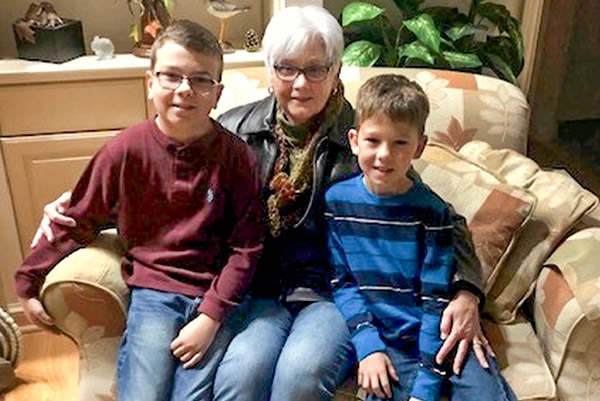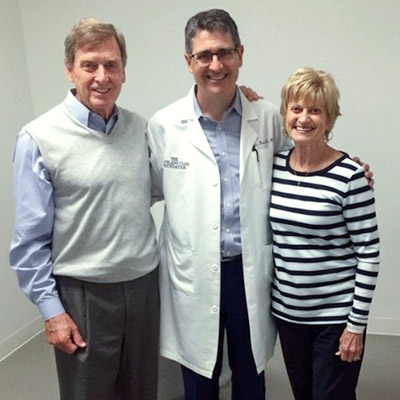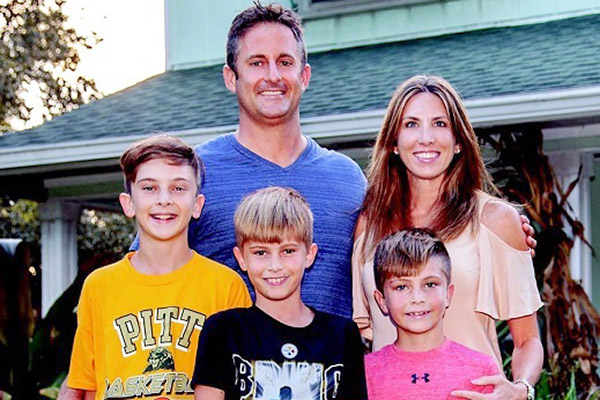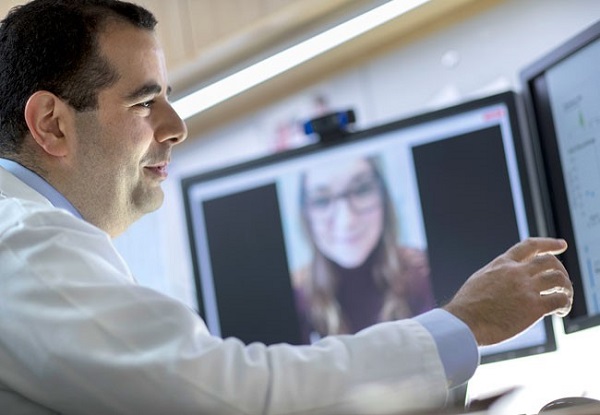A Steady Beat: Heart Transplant Patient Overcomes Many Obstacles

Jennifer Allen, MD, has been through so much over the past 14 years, she jokes that she must have nine lives.
In 2006, Dr. Allen, a pediatrician with a thriving practice in Chillicothe, Ohio, began experiencing unusual shortness of breath. The symptoms became bad enough that she went to the Emergency Department, thinking she was having a heart attack. Doctors discovered that she was in heart failure and implanted a pacemaker. Then she needed emergency surgery to drain fluid from her pericardium.
Still not feeling quite right, she tried to return to her work. From December 2006 through October 2007, she met with cardiologists and pulmonologists, but no one was able to help her.
Finally, she visited her internist and said, “I’m either really crazy or really sick. And in order to work as a pediatrician, I need to know which it is!”
It turned out that she was really sick.
Her doctor referred her to Cleveland Clinic. Again, her tests were normal, even though it was clear she had shortness of breath. Next her pacemaker was evaluated. Tests showed that when her heart rate went up, her cardiac output went down. Usually when heart rate increases, cardiac output increases as well.
Cardiologist W.H. Wilson Tang, MD, of Cleveland Clinic’s Sydell and Arnold Miller Family Heart, Vascular and Thoracic Institute, performed a heart biopsy. He told Dr. Allen and her husband, Alan Davis, to head home and the results would be available in a week. The couple was only an hour into their trip when Dr. Allen’s cellphone rang. “It was Dr. Tang telling me I had cardiac sarcoidosis. We were both surprised because I didn’t have it anywhere else.”
Cardiac sarcoidosis
Sarcoidosis is an inflammatory disease affecting one or more organs, most commonly the lungs and lymph glands. As a result of the inflammation, abnormal lumps or nodules, called granulomas, form in one or more organs of the body. These granulomas may change the normal structure and possibly the function of the affected organs. And while heart disease is present in 28% of patients with sarcoidosis, only about 5% of patients report having any heart-related symptoms. It’s unusual to have cardiac sarcoidosis without having other organs affected.
Treatment with high doses of steroids did little to improve Dr. Allen’s condition. After developing an allergic reaction to arrhythmia drugs, she was running out of treatment options. A heart transplant was the best course of action.
“I was 55 years old at the time,” Dr. Allen says. “I wasn’t sure I wanted a transplant … as a pediatrician, I know that younger people need hearts. We had a decision to make.”
Faith is an important part of her life. Upset about making such a monumental choice and wanting to help herself relax, she picked up a book of devotionals that was on her nightstand. “It fell open to page with a Bible passage that read, ‘I will give you a new heart. I will take your heart of stone and replace it with one of flesh.’ And the picture was of a heart with a zipper on it. I screamed for my husband; I think he thought I was dying,” she says with a laugh. “We looked at each other and knew the decision had been made. We would begin this transplant journey.”
At this point, Dr. Allen had a combination pacemaker/defibrillator implanted. She was placed on the transplant list in June 2008. But in July she fell and broke her back and was taken off the list until September when she had healed.
Then, as Dr. Tang says, things became dramatic.
Serendipity Plays a Part
It was October 31, 2008, and Dr. Tang had driven three hours to speak at a cardiac symposium at the hospital in Chillicothe. He was expecting to see Dr. Allen there, but she wasn’t in the room.
She had a good reason for her absence. “That morning, my defibrillator went off twice,” recalls Dr. Allen. “I called 911 and by the time the EMS arrived it had gone off five times. By the time I got to the ED it had gone off a total of 53 times.”
Dr. Tang heard about what happened to Dr. Allen and went over to the Emergency Department to see her. “It was like I was making a house call,” he says, chuckling now about the timing of it all. He called the heart failure intensive care unit directly to arrange for the transfer, and reassured Dr. Allen and her husband, telling them she would be life-flighted to Cleveland Clinic and wouldn’t come home until she had a new heart.
“As I was actually giving my talk at the symposium, I could hear the helicopter taking off en route to Cleveland,” Dr. Tang says. “It was a movie moment.”
On the evening of December 4, 2008, a donor heart became available for her transplant. Tom Mihaljevic, MD, now CEO and President of Cleveland Clinic, performed her surgery.
“My life is to honor Adam … my donor,” Dr. Allen says with a catch in her throat. “Organ donors and their families are so important.”
Appreciation on Both Sides
Dr. Allen went home at the end of January 2009. Since then, she broke her elbow, had to have her medication adjusted and even needed another pacemaker. None of it has affected her positive outlook. And while she had to retire from her medical practice, she is a grateful patient.
“We think so highly of Dr. Tang and Cleveland Clinic,” she says. “Alan was a CFO of a hospital but knows nothing about medicine. Dr. Tang was always so good about explaining what was happening without being condescending. So we give $100 every month and have made a planned gift in our will.”
Their support has long-term benefits. “Helping to support research fellows, hosting visiting researchers to share their latest insights, curate and analyze data to inform care, to explore opportunities to do further investigations – their contributions help with all of this,” Dr. Tang says. “Dr. Allen and Mr. Davis both understand that in 20 or 30 years, someone with the same problem will want answers. We are all trying to not only care for patients now, but find better ways to treat tomorrow’s patients.”
How You Can Help
Gifts of all sizes make a difference to our researchers and physician-scientists. Your gift has the power to help today and tomorrow.
An Unplanned Visit to “The Place for Hearts”

Until two years ago, Linda Foster hadn’t experienced any serious health problems. For the Atlanta resident, physical well-being is a top priority, so she exercises, makes regular visits to her doctor and follows a balanced diet. However, during one of her routine checkups, doctors found a lump in her heart. After testing, Foster received a shocking diagnosis: an aortic aneurysm.
When the aorta wall is weakened, the pressure of blood pumping can form a bulge, which can grow and rupture if it becomes too large. Perhaps the scariest aspect of an aortic aneurysm is that patients rarely experience outward symptoms. That was true for Foster. If she hadn’t had an X-ray screening, the aneurysm may have gone unchecked, leading to life-threatening bleeding or even death.
Once Foster knew she had a problem, she knew where she wanted to go to have it fixed. “Cleveland Clinic is the place for hearts,” she says.
During her pre-surgery visit, Foster instantly recognized the high quality of care that patients receive at Cleveland Clinic. “I was so impressed by the people and the system,” she says. “I can’t say enough good things about the people who work there -- they take care of everyone so quickly and efficiently. That doesn’t happen everywhere.”
When she first met her surgeon, Eric Roselli, MD, Chief of Adult Cardiac Surgery and Director of the Aorta Center at the Sydell and Arnold Miller Family Heart, Vascular & Thoracic Institute, she knew that he would fix her. “Dr. Roselli’s heart is in his work,” she says. “He feels what his patients feel, and I’m very much at ease with him.”
Grateful for her care, Foster and her husband, John, donated $25,000 to support Dr. Roselli’s research into aortic disease.
Philanthropy has always played an important role in Linda Foster’s life. In 2012, she traveled to Kenya with Wesley Methodist Church, where she taught women financial savviness and how to be self-supporting. “I love to give back,” she says. “Community is so important to me.”
And community is exactly what she found at Cleveland Clinic. Every person she encountered before, during and after her surgery made her feel important and cared for, Foster says. “No matter who they were, they would drop everything to help me. That’s the quality of people you have at Cleveland Clinic.”
How You Can Help
Your gift to Cleveland Clinic helps further research that impacts patients around the world.
Florida Campaign Focuses on Healthy Moms and Babies

Rebuilding for a Better Patient Experience
New families at Cleveland Clinic Indian River Hospital soon will have even more to celebrate. Inspired by its top outcomes in infant and maternal health, Indian River Hospital recently launched the Mother-Baby Campaign to renovate the Women’s Care Unit with expanded birthing spaces and the latest technology and equipment.
“As the only hospital in the county that delivers babies, we’re committed to safeguarding the health and well-being of all expectant mothers and their newborns,” says Megan McFall, RN, Director of Women’s Health at Indian River Hospital. “Upgrades to our facility in conjunction with our current best practices ensure the highest levels of patient safety and quality of care.”
Indian River County has seen marked improvements in infant and maternal health in recent years, sustaining a zero rate for maternal mortality for 14 years and the lowest infant mortality rate in 27 years. The county’s rate of infant deaths in the first year of life also is down to 1.5 deaths per 1,000 births, well below the state average of 6 per 1,000 births.
Much of the credit goes to Partners in Women’s Health, a cooperative effort between the Indian River County Hospital District and Indian River Hospital’s obstetrics and gynecology practice, which delivers approximately 80 % of all newborns in the county.
“Our caregivers have built one of the safest programs in Florida for obstetrical, gynecological and infant care,” says George Fyffe, MD, Department Chair of Obstetrics and Gynecology at Indian River Hospital. “Despite our success, there is always opportunity to do better, and modernizing the Women’s Care Unit is part of that effort.”
A New Generation of Care
Planned renovations for the unit will support today’s family-centered model of care. It focuses on the “mother-baby couplet,” an evidence-based practice known to increase bonding, and the importance of a supportive family.
“When our unit was last remodeled, newborns would go to the nursery after delivery,” McFall explains. “Now babies stay with their moms, only going to the nursery when they have a complication.”
Moms also are encouraged to have a family member or friend stay with them in their room and to participate in new-mom education.
The renovation will not alter the footprint of the Women’s Care Unit, but it will completely change how the space is used, all with an eye to improving the patient experience. Enhancements will be made to labor and delivery, postpartum rooms, gynecologic surgical rooms, the nursery, and procedural and testing areas.
Post-delivery rooms will be enlarged and equipped with wheelchair-accessible bathrooms and bigger shower stalls. Surgical rooms and the nurses’ station will be fully refurnished and updated with the latest technology in anticipation of the installation of new electronic medical records software.
“The renovations also will leave space for future needs to accommodate population growth or change in the level of acuity care needed,” Dr. Fyffe says. The hospital delivers about 1,100 babies a year for routine and high-risk obstetrical patients, and sees approximately 2,600 triage and emergency visits by pregnant women annually.
Connecting with Young Donors
Through support from past campaigns, Indian River Hospital has improved care and services for other conditions impacting the community – heart disease, stroke and cancer.
The Mother-Baby Campaign is unique in two respects, according to Greg Rosencrance, MD, President of Indian River Hospital. “Not only is it focused on well-care services, keeping mothers and babies healthy, it is the first campaign to engage so strongly with younger donors, like John and Emily Colontrelle of Vero Beach.”
The Colontrelles are beneficiaries of the community’s philanthropic support of the hospital. At age 31, John was diagnosed with an aortic dissection, a life-threatening condition requiring open heart surgery. “Without the generosity of the donors who funded our heart center and the skill of Dr. Cary Stowe, I would not be alive today,” says John.
Just one year later, John and his wife were back at the hospital welcoming their third son. All three Colontrelle children were born at Indian River Hospital. John and Emily now champion the renovation of the Women’s Care Unit to ensure the space matches the high caliber of care they received.
The Mother-Baby Campaign launched in December with a goal of $12.25 million.
“A hospital isn’t just a place you go when you’re sick or injured; it’s a place where lives begin,” reflects John. “Whether it’s for heart care or the birth of a child, we all need to support the great care at Indian River Hospital.”
How You Can Help
You can help modernize the Women’s Care Unit at Cleveland Clinic Indian River Hospital and create a warm, nurturing environment for the hospital’s youngest patients and their mothers. Every gift makes a difference.
How accurate is your fitness tracker?

“Smart devices can only be smart if used intelligently.”
That’s the message from Khaldoun Tarakji, MD, MPH, who’s researching the pioneering field of wearable technology as it relates to medicine.
Cleveland Clinic, ranked No. 1 in heart care for 25 years by U.S. News & World Report, is delving deeper into this emerging field to provide the expertise necessary to further understand how to properly use technology such as smart watches, fitness trackers and smartphone-paired apps. Collectively known as wearable devices, or “wearables,” the devices track health data, ranging from heart rate and calories burned to blood pressure and steps walked.
At Cleveland Clinic’s recently established Center for Digital Health and Telemedicine, the mission is to bridge the gap between digital health and clinical care through research and education by assessing these technologies and providing guidance to patients, healthcare providers and the community at large.
Dr. Tarakji, who leads the new center, is a staff physician in the Section of Electrophysiology and Pacing in the Robert and Suzanne Tomsich Department of Cardiovascular Medicine, part of the Sydell and Arnold Miller Family Heart, Vascular & Thoracic Institute (HVTI). Dr. Tarakji is also a member of the Digital Health Committee for the Heart Rhythm Society and a pioneer in the use of digital technology in cardiovascular medicine.
“As an early adopter of digital technology and wearables in the care of arrhythmia patients, I have seen the great impact these devices can have,” Dr. Tarakji says. “I have also seen the lack of guidance given to our patients and physicians about all these advances. We built our HVTI Center for Digital Health and Telemedicine to fill this gap and transform the care of our patients today and the patients of the future.”
His aim is to ensure that patients who use wearables receive accurate information. “No one is guiding the patient or consumer when it comes to the products they might need, and many products are released to the market without the proper validation,” he says. “Physicians have been on the receiving end of this surge in wearables and have not been able to keep up with this technology.”
Until recently, patients couldn’t collect much useful data on their own. “Patients now have the ability to record and track things like their electrocardiogram and sleep patterns. The ability to independently record your heart rhythm, for example, has truly transformed the care of the arrhythmia patient, especially atrial fibrillation, and the same could be done to a variety of heart diseases,” Dr. Tarakji says.
Philanthropic support already has resulted in 14 different research papers on wearables published by Dr. Tarakji and his team. With more funding, the team will be able to cover the significant costs of collecting solid data that ultimately will lead to better patient care.
How You Can Help
Your gift will help advance research into wearable technology, improving lives today and for future generations.

